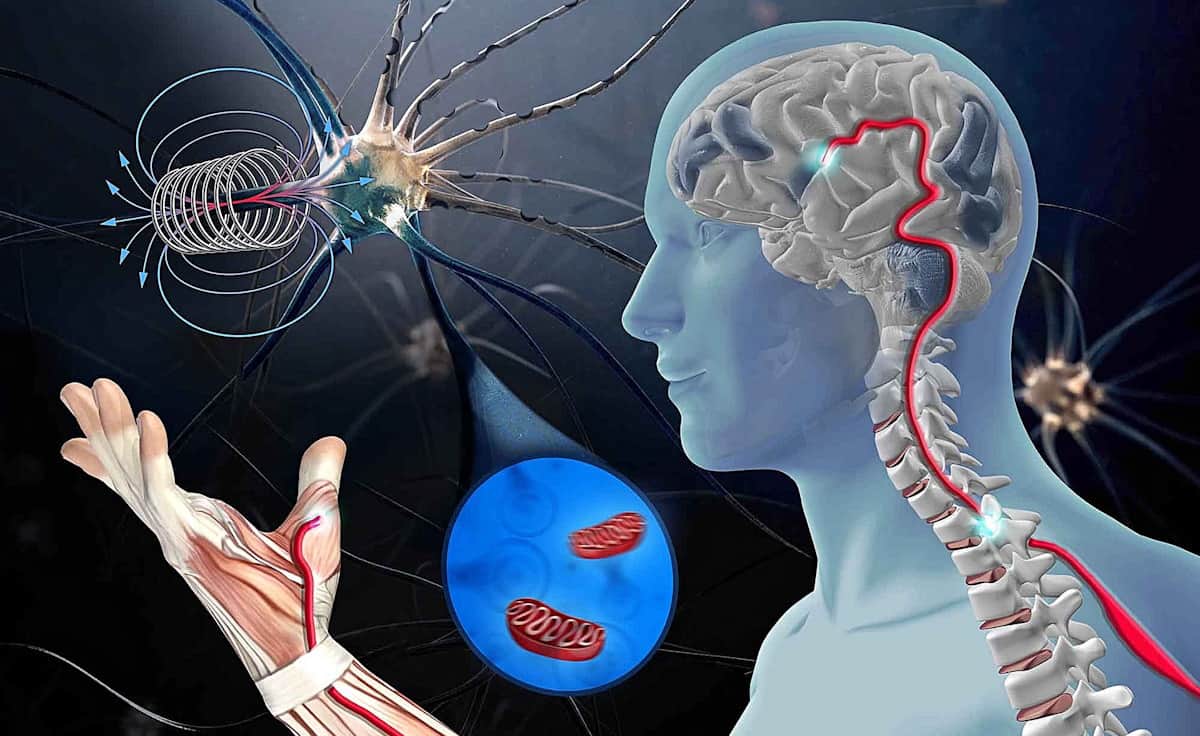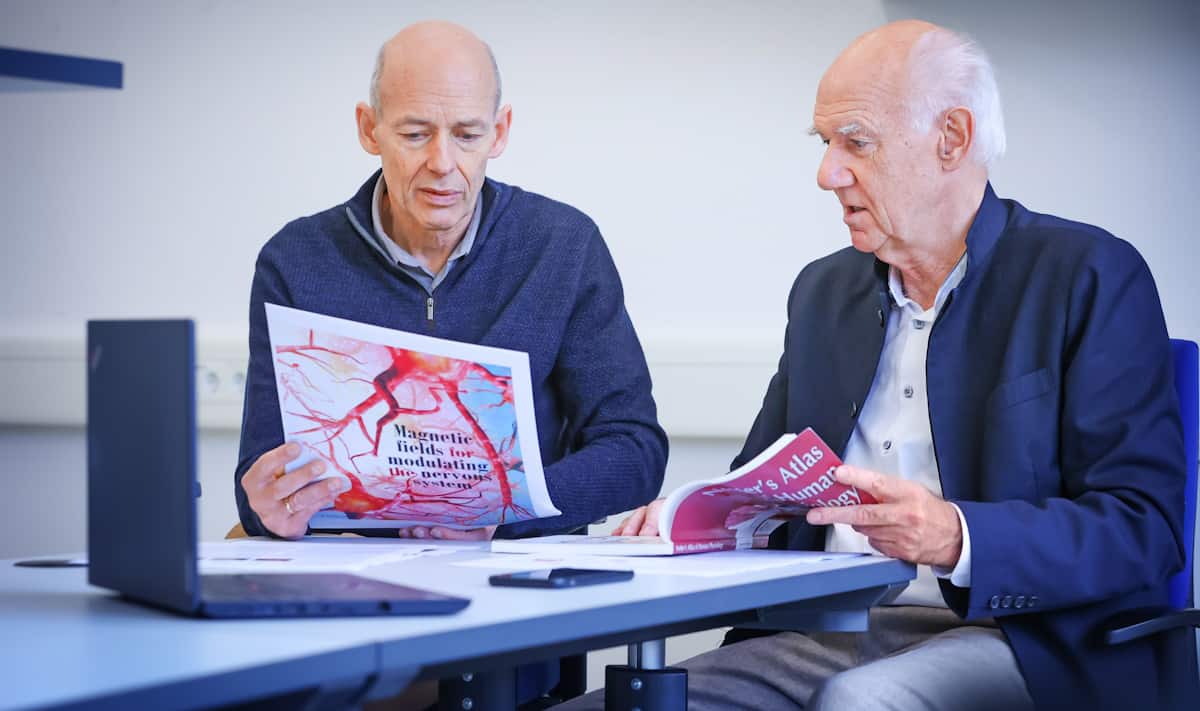Towards a cure for ALS: magnetic stimulation restores impaired motoneurons
05 Jul 2023 Tami Freeman
Reactivating damaged motoneurons Thomas Herrmannsdörfer (left) and Richard Funk are investigating the therapeutic effect of magnetic fields on impaired motoneurons. (Courtesy: HZDR/Amac Garbe)
Amyotrophic lateral sclerosis (ALS) is a severe incurable disorder in which motoneurons – nerve cells in the brain and spinal cord that send signals to muscles to control movement – are damaged. Without functioning motoneurons, the muscles do not receive instructions and no longer work, leading to progressive paralysis, muscle atrophy and, eventually, failure of the respiratory system.
Currently, there is no successful treatment for ALS, with drug therapies only having a marginal impact on patient survival. Aiming to address this shortfall, an interdisciplinary research team headed up at Helmholtz-Zentrum Dresden-Rossendorf (HZDR) and TU Dresden is investigating the potential of using magnetic fields to restore impaired motoneurons.
The influence of magnetic stimulation on neuronal diseases has been widely investigated. However, applications in peripheral nerves are scarce. In this latest study, reported in Cells, the researchers assessed whether magnetic stimulation of peripheral motoneurons could restore defects in stem cell-derived motoneurons from ALS patients with mutations in the FUS gene (FUS-ALS).
The team – headed up by physicist Thomas Herrmannsdörfer, cell biologist Arun Pal and physician Richard Funk, and supported by colleagues at TU Dresden and the University of Rostock – generated spinal motoneurons by reprogramming induced pluripotent stem cells obtained from skin biopsies of healthy individuals and patients with FUS-ALS. They designed and fabricated electromagnetic coils that can be operated in cell culture incubators, and used these to expose the motoneurons to tailored magnetic fields.
Each magnetic stimulation comprised four consecutive treatments (several hours in duration) using very low square-wave frequencies of 2 to 10 Hz. The treatments were performed after the cells had matured for 30 to 45 days in vitro, with the coils switched off in between. After the final treatment, the team maintained the cells in culture for two days before assessing the impact of the magnetic stimulation. Towards a cure Pulsed magnetic fields could help fight neurodegenerative diseases. (Courtesy: HZDR/Sahneweiß)
Towards a cure Pulsed magnetic fields could help fight neurodegenerative diseases. (Courtesy: HZDR/Sahneweiß)
 Towards a cure Pulsed magnetic fields could help fight neurodegenerative diseases. (Courtesy: HZDR/Sahneweiß)
Towards a cure Pulsed magnetic fields could help fight neurodegenerative diseases. (Courtesy: HZDR/Sahneweiß)Restoring axonal defects
Motoneurons possess lengthy projections called axons, which can measure up to 1 m long, that transport substances and transmit information. Impairments in the transport of axonal organelles such as mitochondria and lysosomes contribute to neuronal degeneration in ALS. Thus the researchers used live cell imaging and immunofluorescent staining to measure the motility of these organelles in motoneurons exposed to magnetic fields.
They first examined the mean organelle speed. Quantitative tracking analysis revealed a decreased distal mean speed for both mitochondria and lysosomes in untreated mutant FUS motoneurons compared with control cells (derived from healthy donors). Exposure to magnetic fields reverted the mean speed in FUS motoneurons back to control levels, with the best effects seen using very low frequencies of about 10 Hz.
Another hallmark of ALS is a diminished ability of axons to grow and regenerate after injuries or during aging. Such growth is crucial for maintaining inter-neuronal connectivity across nerve endings and transmitting information. To study whether magnetic stimulation could improve such defects, the team used live imaging of cells in microfluidic chambers to analyse the new outgrowth of axonal growth cones after axotomy (severing of an axon).
The researchers observed a reduced mean axonal outgrowth speed in untreated FUS motoneurons compared with control cells. Magnetic stimulation of the FUS motoneurons at 10 Hz significantly increased the mean outgrowth speed back to control levels. The magnetic fields did not affect the mean outgrowth speed in control motoneurons.
In numerous experiments, the researchers showed that motoneurons from ALS patients respond to the magnetic fields, with impaired axonal transport of organelles reactivated by stimulation and axonal regeneration restored. Importantly, they also demonstrated that healthy cells were not damaged by the magnetic stimulation.READ MORE

While these findings appear promising, the team highlights the need for long-term and in vivo studies. “We regard these in vitro results as an encouraging approach on the path to a potential novel therapy for ALS, as well as other neurogenerative diseases,” says Herrmannsdörfer in a press statement. “We also know, however, that detailed follow-up studies are required to corroborate our findings.”
Now working within the ThaXonian project, Herrmannsdörfer and his colleagues are planning further studies to optimize the parameters of the applied magnetic field, understand the cellular response to various magnetic stimuli, and test the treatment on other neurodegenerative disorders, such as Parkinson’s, Huntington’s and Alzheimer’s diseases.

Tami Freeman is an online editor for Physics World
FROM PHYSICSWORLD.COM 23/7/2023

Δεν υπάρχουν σχόλια:
Δημοσίευση σχολίου